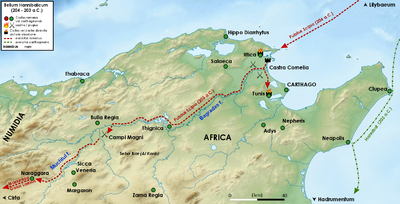Siege of Utica
The siege of Utica took place from 204 to 201 BC when a Roman army under Publius Cornelius Scipio attempted to seize the port to use as a secure base from which to defeat the Carthaginian Empire in its North African homeland.
After a further 13 years of war Scipio, Rome's most successful commander, was assigned to Sicily with the intention of invading the Carthaginian homeland in North Africa.
Scipio's army landed in North Africa in 204 BC, pillaged a large area and laid siege to the port-city of Utica, intending to use it as a permanent base and a harbour proof against the winter weather.
Scipio expected the city to surrender readily, but despite being attacked fiercely from land and sea it held out; the garrison and citizens assuming they would be relieved from Carthage.
A large Carthaginian army, supported by a larger force of allied Numidians set up camp 11 kilometres (6.8 mi) south of Utica.
The Carthaginian army reassembled 120 kilometres (75 mi) from Utica, but the Romans marched to meet them, leaving the siege largely in the hands of the navy.
The Romans enforced harsh terms in the subsequent peace treaty, agreed in 201 BC, although they did leave North Africa and Utica remained a Carthaginian city.
[1] The Carthaginians were defeated[2][3] and by the terms of the Treaty of Lutatius evacuated Sicily and paid Rome an indemnity of 3,200 silver talents[note 1] over ten years.
[6] Four years later, Rome seized Sardinia and Corsica on a cynical pretence and imposed a further 1,200 talent indemnity,[note 2][7][8] actions which fuelled Carthaginian resentment.
He was given permission to cross to Africa on his own judgement;[24] but Roman commitment was less than wholehearted, Scipio could not conscript troops for his consular army, as was usual, only call for volunteers.
[27][28] With up to half of the complement of his legions being fresh volunteers, and with no fighting having taken place on Sicily for the past five years, Scipio instigated a rigorous training regime.
[32] Carthage's immediate response, a scouting party of 500 cavalry, was defeated with the loss of its commander and the general in overall charge of responding to the invasion.
[35][34] The garrison and citizens of Utica assumed they would be relieved from Carthage, although the Carthaginian navy made no attempt to challenge the Roman control of the sea.
[36] The siege continued until a Carthaginian army of 33,000 men under Hasdrubal Gisco set up a fortified camp 11 kilometres (7 mi) south of Utica.
They pulled back to a fortified camp on a rocky peninsula near Ghar el-Melh[33][38] which was known as Castra Cornelia, about 3 kilometres (2 mi) east of the city.
[35] The three armies stayed in their camps throughout the winter, although emissaries were exchanged and negotiations to either end the war or to facilitate a Roman withdrawal from Africa took place.
[41] While the Roman navy demonstrated off Utica Scipio briefed his senior officers that in fact they were going to launch night attacks on the enemy camps.
Laelius's column attacked first, storming the camp of Syphax's Numidians and concentrating on setting fire to as many of the reed huts housing them as possible.
The camp dissolved into chaos, with many of its Numidian occupants oblivious of the Roman attack and thinking the barracks had caught fire accidentally.
[45] The combined force is estimated to have been 30,000 strong and they established a fortified camp on an area of flat ground by the Bagradas River known as the Great Plains.
[58] Over the winter the Carthaginians had increased the number of equipped and crewed war galleys they had, and now felt ready to challenge the Romans at sea.
Roman scouts observed the Carthaginian galleys departing and sailing north and Scipio realised the threat they posed to his fleet.
By the time they arrived the Romans had expediently lashed the whole of their fleet into one unit, with several ranks of transports in front of the specialist war galleys.
Each rank of transport ships had a passageway installed running its length, making it easy for these marines to move from one point of danger to another.
[55] Instead they faced a tight-locked wall of transports, whose higher freeboard meant the Carthaginians had to improvise grappling hooks or ladders to board them.
[62] Hannibal was placed in command of another army, formed of veterans from Italy and newly raised troops from Africa, with 80 war elephants but few cavalry.
An indemnity of 10,000 silver talents[note 4] was to be paid over 50 years, hostages were taken, Carthage was forbidden to possess war elephants and its fleet was restricted to 10 warships.



